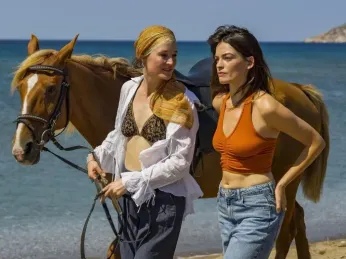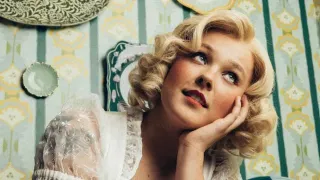
Jul 4
‘Hot Milk’ – Sapphic cinematic sensuality
Joshua Polanski READ TIME: 2 MIN.
Rebecca Lenkiewicz’s directorial debut “Hot Milk” (IFC Films) is a fitting release for our a long hot summer. Adapted from Deborah Levy’s acclaimed novel of the same name, Lenkiewicz’s debut puts three women –Emma Mackey, Vicky Krieps, and Fiona Shaw– at the center of a life-changing European summer of parasitical relationships, intense emotions and sensual expression, trauma sharing, and a search for independence. It also makes for a pretty good queer addition to the “summer romance” sub-genre with lovers languishing with longing in the picturesque Greek beach town that the filmmakers confidently transform into idyllic Spain.
Mackey plays Sofia, a struggling anthropologist in her late 20s who spends most of her time as her mother’s full-time caregiver. Her mother Rose (Shaw)’s paralysis means she can’t walk and uses a wheelchair… other than the odd time or two a year when she can walk. Sofia is fully and completely responsible for her mom and has been since she was first paralyzed when Sofia was only four.
Beach meet
They trek from England to Spain to see a specialist with a rather abnormal practice. In her rare free time on the beach apart from her mother, Sofia finds herself with a gravitational-like attraction to Ingrid (Krieps), who first towers into the frame like a storybook character on a beautiful horse while riding on the beach.
Ingrid and Sofia meet almost exclusively in isolation from Rose and this seems to be part of the attraction for Sofia. It doesn’t seem that she is hiding her same-sex pursuits from her mother, but rather that caring for her mother takes so much of her time and emotional energy that Rose’s separation from her mother adds to her allure.
Ingrid is almost a decade older and much more carefree. The age difference matters mostly as a reflection of Margaret Mead’s theory that we are flexible but elastic, and thus we usually “snap back” to what we are familiar with (including picking romantic partners), which Sofia explicitly names in their first “date.”

The bandana Krieps straps to her hairline gives something of a hippie nonchalance to the character. And her horseback entrance, with the camera peering up, affects a power dynamic that holds throughout. Her nonchalance sometimes translates into selfishness and she doesn’t realize how she hurts her more innocent, and more monogamous, lover. They aren’t soulmates or destined lovers, but they do become very important to one another over their shared summer in Spain.
Ingrid and Sofia have relations with both each other and with men. “Hot Milk” imagines a Europe where queerness has been so normalized that even in a small, remote community it demands no special commentary or navigation; it’s just a fact of their lives. All of the men are unimportant with the lone exception of the unorthodox Dr. Gomez (Vincent Perez). The two most important people behind the screen are also women: writer and director Lenkiewicz, who also wrote the brilliant “Disobedience,” and the original writer Levy.
Sensual moments
It’s a much more sensuous film than a sexy one, though. Bodies and physical touch are important in ways that go beyond the catharsis of sex. The only nudity comes in a nip-slip after Sofia gets stung by a jellyfish. When the women shower together, they embrace and certainly sex is implied, but the scene is much more about a comforting intimacy than all-consuming and lewd desire. Ingrid plays the part with a bit of maternal energy and that can’t be easily missed. Most obviously, in at least two scenes, Mackey lays her head in Krieps’ lap almost like Mary and Jesus in “The Pieta.”
The title is a bit of a puzzle. Maybe it’s easier to understand in the book, but the phrase “hot milk” never appears. Nor does any milk itself. There are no relevant sexual acts for the title to qualify as a possible innuendo either. Most likely, it has something to do with maternity and the troubled mother-daughter relationship at the center that Sofia simultaneously projects sexually onto her older lover but nothing can be said with certainty and that’s fitting given the film’s opaque and open-ended final scene.
Rose’s paralysis is real, and the screenplay is smart to never truly doubt that; it just is psychological or neurological rather than strictly physical. It’s also very near to the crux of the story. The thematic and visual motif of shackles begins with Rose’s wheelchair, a symbol of limitation to both Rose and Sofia, and persists with the latter’s lack of a driver’s license, and even a cruelly chained dog that barks incessantly. The dog’s tortured barking cries out the tears Sofia holds back.
The open-ended final shot can also be interpreted as either a liberation of these shackles or a dark affirmation of our ultimate subjugation. Lenkiewicz, in a podcast about the film (see below), called the ending a personality test for the audience. What one thinks happens at the end mirrors one’s personality. Apparently, that makes this viewer a nihilist.







